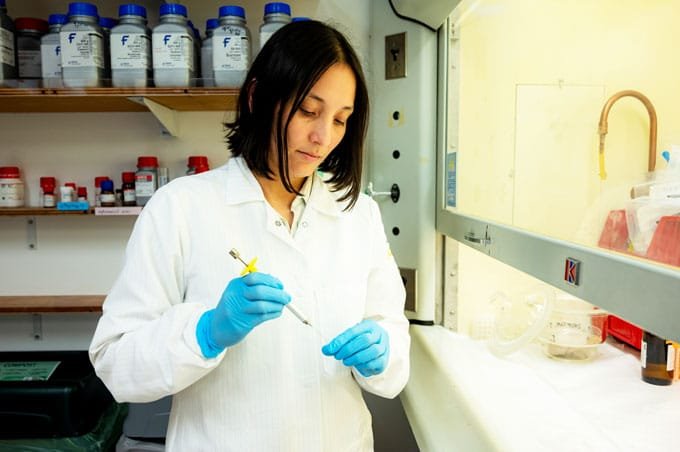One of the most remarkable things about the human brain is that it changes. A lot. This ability to reinvent oneself, to take shape, to strengthen some ties and let others go, fascinates Andrea Gomez.
A molecular and cellular biologist at the University of California, Berkeley, Gomez spends her time trying to understand how the brain stays flexible, but not too flexible (SN: 7/27/12).
The human brain operates on a knife’s edge, a fine-tuned compromise between flexibility and rigid structure, Gomez says. Too much plasticity would turn into chaos. “We would never have a form of memory. We would never learn anything,” she says. But too much rigidity would be just as disastrous. “Some of the most interesting questions, to me, are what mechanisms, what biological features allow us to live at that edge.”
Gomez’s research ranges from tiny channels — for example, tiny channels called synapses that sprout between nerve cells — to large changes in behavior. That broad curiosity is one of her hallmarks as a scientist, says Peter Scheiffele, a neurobiologist at the University of Basel in Switzerland and her former postdoctoral adviser.
He remembers when Gomez, who had been studying the brain, became fascinated by the gut. She began experimenting with the idea that molecular instructions could help pattern the gut in the same way they pattern the brain, but work was halted by COVID-19.
“I don’t see this as a story of lack of success,” Scheiffele says. “I see it as the opposite – a story of genuine enthusiasm, motivation and, at some points, a certain serendipity, but a creative serendipity.” It’s a story to say, “Hey, this is cool. I really want to talk about it and see if there’s something exciting going on,’” Scheiffele says. “That to me is symbolic of how she often deals with science.”
Scheiffele says some scientists are linear thinkers who stick to a rigid plan. Gomez is more “blue sky, get out there and challenge yourself, challenge a problem,” he adds. She goes optimistically and says, “Let’s see.”

This “let’s see” energy has led Gomez to many major changes in her research directions. As an undergraduate at Colorado State University in Fort Collins, she studied crustacean molting, among other things. Then, as a graduate student at New York University, she eventually moved into the brain, studying the plasticity of nerve cell connections.
While working in Scheiffele’s group as a postdoc, she and her colleagues made a surprising discovery about how certain synapses are built.
Detection depends on a process known as “joining”. Cellular machinery not only copies information continuously and faithfully from DNA. These messages can be cut and recombined, or joined, to form new versions of proteins. These combined messages are “opportunities for something to be different,” says Gomez.
It turns out that, at least in the brains of mice, a version of a protein that results from a splicing event dramatically affects the synapses of certain nerve cells. When that version of the protein was missing, these synapses weren’t as responsive as they should be, and the mice went from being curious about new objects to avoiding them, the researchers reported in 2016 in Science.
The results “made us and many people in the field start to think very differently about what fusion does in the nervous system,” says Scheiffele, a co-author of the paper. “It’s not a good kind of arrangement. It could be a fundamental change.”
These days, Gomez has a new focus. Instead of looking at how internal proteins enable the change, she has begun a project on an intriguing external way to shift the brain – psychedelic drugs.
Psychedelics are thought to open windows of plasticity in the brain in ways that scientists don’t fully understand. One way this flexibility can emerge is through mergers, Gomez suspects. A single dose of psilocybin led to thousands of fusion events in the brains of mice that did not occur without the drug, Gomez and her colleagues have found in preliminary research. “That, to me, is such a rich repertoire for discovering new mechanisms of plasticity,” she says, “and that’s really my goal.”
The effects of psychedelic drugs on the brain are still, in general, a mystery, says Gordon Fishell, a developmental neurobiologist at Harvard Medical School and the Broad Institute. “Anything that so deeply affects your sense of self, being, identity, consciousness is fundamental to the way we think about how the brain works,” he says.
Other post-psychedelic changes abound: There are changes in gene activity and a reduction in the rigid structures around nerve cells that have been implicated in memory storage, called perineuronal networks.SN: 10/20/15). Some of the biggest changes occur in the activity of nerve cells in a part of the brain that deals with perception.
Gomez is from Las Cruces, NM, and is a member of the Laguna Pueblo Tribe. “I heard about psychedelics before I started working with it, from an indigenous perspective, all the way back to high school.” Soon after she arrived at Berkeley and began setting up her new lab, a young colleague floated the idea of teaming up to study how psychedelics make the brain more flexible—another example of Gomez being open to change. and saying, “Let us see.”
#cell #biologist #investigating #balance #brain #flexibility #stability
Image Source : www.sciencenews.org
